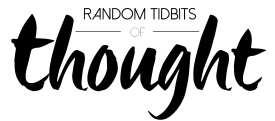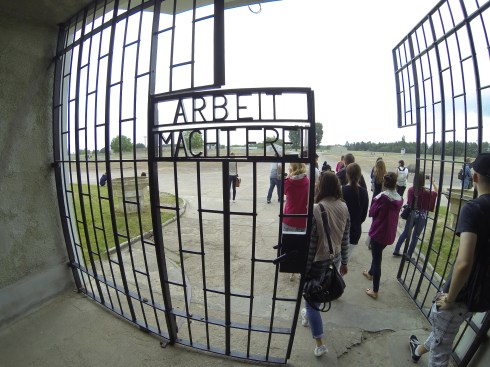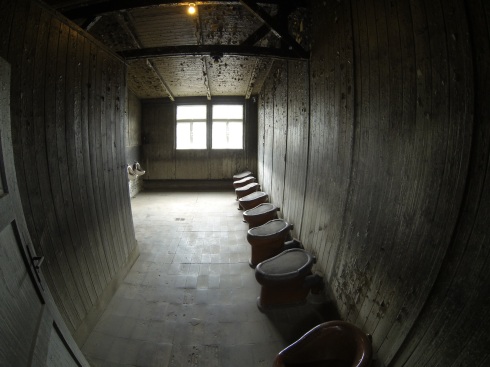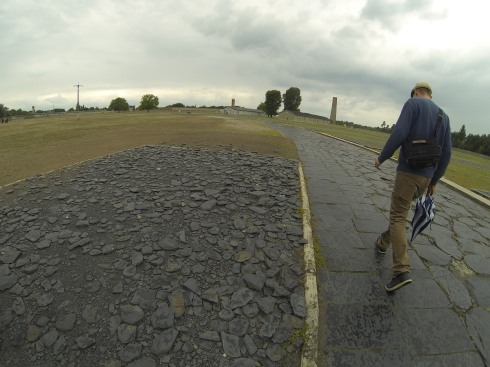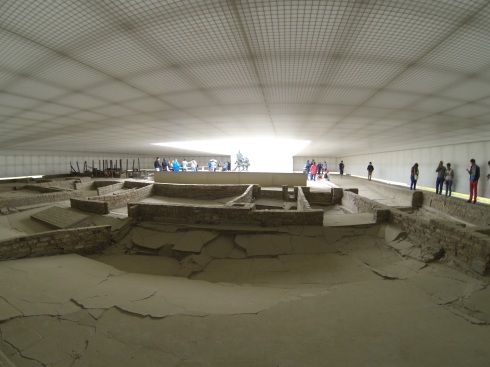Our visit to Sachsenhausen concentration camp today was one of the most thought-inducing and memorable visits of our trip thus far. This was our first paid guided tour with Sandeman’s, and I have to say it was the best one yet. Our guide Rob, a Manchester native now living in Berlin, was phenomenal, full of knowledge about the history of the rise of Nazism in Germany and its concentration camps. He was also constantly challenging us to think about humans and the world today, which was quite a feat given the tight four hours we spent at the camp.
At the start of the tour, we took a look at a giant map showing the entire camp. Sachsenhausen was established in 1936 and started off housing political prisoners, mostly from opposing parties after Hitler came to power. The camp was intended to be the gold standard of Nazi concentration camps – it was originally designed in a triangle format (symbolizing the Nazi hierarchy) and was later expanded and housed Jewish and homosexual inmates.
As we walked through the roll call square and passed through the main gate, Guard Tower A, the cast iron words “Arbeit Macht Frei” (Labor Makes You Free) greeted us against a gloomy sky. Much of the buildings in the concentration camp are long gone, but we could see the areas where the prisoners’ barracks used to stand. Peering to my right, I caught a glimpse of a bed of gravel next to a huge row of barbed wire. The guide explained that this was the “death strip,” where any prisoner who ventured onto it would be immediately shot without warning.
We walked through one of the few barracks still standing and peered into the sleeping quarters and toilets. The area was tiny and cramped, and it was chilling imagining prisoners going through their daily routine. There was a small exhibit beneath the barracks, where we saw some interesting artifacts taken from the camp, such as counterfeit money (Sachsenhausen had prisoners make counterfeit British currency), pieces of clothing and shoes, and original documents and letters.
Our next stop was equally gripping – the “prison within the prison.” Why another one inside the camp? Rob explained that it was used specially to house influential political opponents, where they were tortured in the yard as a warning to the others in the camp.
On our way to the camp kitchen, we walked along the boot-testing track, a track with different kinds of stone and gravel, used by prisoners to test shoes for German companies. Being assigned this duty was a death sentence, since these prisoners marched a mind-boggling 26 miles each day, carrying heavy packs and often wearing too-small shoes, back and forth on the track. All free labor for shoe companies, with the same meager food rations. Some did this for 10 days…I can’t even being to imagine…
After the camp kitchen, we stopped by the most heart-wrenching portion of our walk – the execution trench and crematorium, also morbidly known as “Station Z.” Our guide vividly described the execution process before the Nazis switched to gas chambers – the execution area was disguised as a medical examination station and the execution cycle took roughly sixty seconds.
By this time it had started to rain and we looked in silence at the remains of these buildings. After reconvening, Rob had some parting words. It boiled down to this: most of the people who committed these acts were ordinary citizens, not just the Nazi leadership. People simply looked the other way, followed orders, or spread their responsibility to someone else (Truck driver of the infamous gas vans: “I was just driving a truck”). Without getting too preachy, I think anytime we’re reminded of the Holocaust and Nazism, it’s a good wake-up call about our roles in society today, especially the absolute necessity of not being silent when something is clearly not right. I’ll finish this post with a quote that Rob shared with us, by Dr. Martin Luther King, Jr.: “In the end, we will remember not the words of our enemies, but the silence of our friends.”
Stay tuned and read about my other adventures in London, Paris, Berlin!
Steps taken: 16,436 | Miles walked: 5.44
—
Old town, new town at randomtidbitsofthought.wordpress.com
